
Researchers identified abnormal visual functional connectivity (FC) in addition to other core networks that differentiate anxiety comorbidity from episodic migraine without aura (MwoA). Findings were published in The Journal of Headache and Pain.
Although migraine is commonly accompanied by psychiatric comorbidities, such as anxiety and depression, the relationship between abnormal brain function and psychiatric comorbidities among migraineurs remains largely unclear, the authors wrote.
To address this knowledge gap, the researchers analyzed correlations between the resting-state functional deficits and psychiatric comorbidities in patients with MwoA and obtained patients’ amplitude of low-frequency fluctuation (ALFF) and regional homogeneity (ReHo) values. While ALFF measures the regional intensity of spontaneous brain activity, ReHo “reflects the regional synchronization between a single voxel and its neighboring voxels.”
In addition, “Regional abnormalities in MwoA patients with and without anxiety (MwoA-A and MwoA-OA) were chosen as seeds to conduct FC analysis,” they said.
A total of 49 migraineurs were recruited from an outpatient clinic in China, and all participants did not take any migraine medications at least 1 month prior to enrollment. Migraineurs were also headache free for 3 days before and 3 days after scanning (MRI). Healthy community volunteers served as age-matched controls (HCs).
Migraineurs completed the Mini-Mental State Examination, the Visual Analogue Scale, Headache Impact Test, and Generalized Anxiety Disorder seven-item scale (GAD-7). Any participant with a GAD-7 score greater than 4 was classified as having anxiety.
Of the 49 migraineurs, 27 had MwoA-A and 22 had MwoA-OA. No significant differences in age, gender, or whole-brain volumes were reported among the 3 groups.
Analyses revealed:
- Compared with HCs, the MwoA-A and MwoA-OA patients had abnormal ALFF and ReHo values in the right lingual gyrus (LG)
- Migraineurs also had abnormal FC of the right LG with the ipsilateral superior frontal gyrus and middle cingulate cortex
- MwoA-A patients showed higher ReHo values in the left posterior intraparietal sulcus (pIPS) and abnormal FC of the right LG with ipsilateral pIPS and primary visual cortex compared with the MwoA-OA patients
- MwoA-OA patients showed an increase in the FC with the right posterior cingulate cortex/precuneus (PCC/PCUN), left middle frontal gyrus (MFG) and left inferior temporal gyrus (ITG) relative to the HCs
- ALFF values of the right LG had a positive correlation with anxiety scores in MwoA-A patients
- The abnormal LG-related FCs with the PCC/PCUN, MFG, and ITG were negatively associated with the frequency of headaches in MwoA-OA patients
Overall, “results showed that the MwoA-A patients had significant regional changes within the visual cortex, which were correlated with anxiety,” the authors wrote. “In addition, dysfunction in cognitive networks was associated with the frequency of headaches.”
Findings indicate anxiety comorbidity among migraineurs is associated with a disrupted FC within multiple large-scale networks. The researchers point out results may provide new insights into the pathophysiology of migraine presenting with psychiatric disorders.
Because anxiety scores were measured subjectively, classification bias may be present, marking a limitation. The study also did not include cognitive function assessments or other psychiatric disorders.
“The abnormal FC patterns linking migraine and anxiety can serve as indicators of underlying psychiatric and pathophysiological neural mechanisms,” the researchers concluded. “The abnormal FC patterns may also guide the development of personalized pain medication for migraineurs with anxiety comorbidity.”
Reference
Wei H-L, Li J, Guo X, et al. Functional connectivity of the visual cortex differentiates anxiety comorbidity from episodic migraineurs without aura. J Headache Pain. Published online May 21, 2021. doi:10.1186/s10194-021-01259-x

